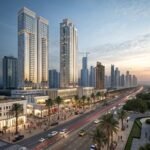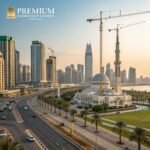Guiding property purchases in the UAE can feel overwhelming – especially when it comes to residency requirements.
There’s a lot of confusion surrounding how much you need to invest to gain permanent residence through property ownership. It’s more than just a down payment; understanding the thresholds is crucial.
Many assume higher investments automatically guarantee residency, but there are specific guidelines that must be followed.
Imagine securing your future in this dynamic region – not just owning a beautiful home, but also gaining long-term residency with confidence.
Let’s break down exactly what you need to know about property thresholds and how they unlock your path to permanent residence in the UAE.
Guiding Dubai’s traffic chaos
It’s easy to get lost in the dream of owning a property in Dubai – especially when you picture yourself smoothly Guiding those famed city streets.
But let’s be honest, the reality of daily commutes can feel like an endless battle against gridlock, and that adds another layer of complexity to your investment plans.
You might envision a beautiful waterfront villa, but constant delays could mean wasted time and frustration, impacting everything from work meetings to family moments.
The key isn’t just about the property itself; it’s understanding how proximity to major roads and public transport affects its value – and your quality of life.
Every minute spent stuck in traffic represents a lost opportunity, potentially impacting resale value or even your own well-being.
And here’s what many guides overlook: the impact of Dubai’s traffic isn’t just an inconvenience – it’s a critical factor influencing property prices and desirability.
Let’s dive into exactly how this chaos plays out, and what you need to know before making your move.
Property Thresholds Defined – Clarity
Just understanding property thresholds is key when considering residency in the UAE. It’s about knowing what you need to own before you can officially live there.
These thresholds are set by the government and they dictate the minimum value of a property that allows someone to apply for residency.
For example, owning a villa worth AED 700,000 might be enough to qualify you for a golden visa, while a smaller apartment could require a lower investment.
The exact figures can vary depending on the emirate and the type of property – freehold versus leasehold – so it’s important to research specifics.
Essentially, these thresholds act as benchmarks for residency applications, providing a clear pathway for those looking to establish themselves in the UAE based on property ownership.
Tiered Ownership & Benefits
If Tiered Ownership & Benefits is about understanding how property thresholds in the UAE are linked to specific advantages, you’ll find it’s a system designed to reward different levels of investment.
It begins with a basic ownership tier – typically the lowest price range – which offers standard benefits like freehold rights and access to community facilities.
This might include things like shared pools, gyms, and parks, providing a comfortable living environment for those starting out.
Moving up the tiers unlocks more substantial advantages. You’ll notice that higher property values are associated with premium amenities and services.
For instance, properties in the upper ranges may grant access to private beaches, exclusive concierge services, or even preferential rates at local businesses.
Essentially, the tiers create a structure where you gain more value as your investment increases – reflecting the higher level of prestige and benefit associated with owning premium property within the UAE.
Residential Zones & Permits
During property development in the UAE, understanding residential zones and permits is key. It’s not just about building; it’s about ensuring your project aligns with regulations.
Different zones dictate what type of construction you can undertake. For example, a ‘Residential Zone’ primarily allows for housing developments – villas, townhouses, apartment complexes – where people live.
A ‘Mixed-Use Zone,’ however, might permit a combination of residential and commercial buildings, depending on specific stipulations within that zone. It’s important to note that these zones are carefully mapped out by the local authorities.
Obtaining permits is absolutely crucial. These permits aren’t just suggestions; they’re legally binding approvals for your construction plans.
A ‘Building Permit,’ issued after reviewing your design, confirms it meets safety standards and zoning regulations. A separate ‘Occupancy Permit’ ensures the building is safe for people to live in once completed. These permits can be complex, so engaging with a qualified consultant is highly recommended.
Essentially, Guiding residential zones and securing the necessary permits provides certainty for your project— ensuring you build legally and safely within the UAE’s framework.
Luxury Living Thresholds – Wealth
Luxury living in the UAE often hinges on a certain level of wealth. And that’s reflected in property thresholds. These aren’t just about square footage or location; they represent a significant investment and a lifestyle aspiration.
You’ll notice that the price points for luxury properties – villas with private pools, beachfront apartments, or residences in prestigious communities – typically start at considerably higher levels than standard residential options. This reflects the exclusivity and premium amenities associated with these locations.
The cost of land itself plays a huge role. Prime waterfront or mountain-view plots command incredibly high prices. Furthermore, construction costs for luxury homes are significantly greater due to the use of high-end materials, bespoke finishes, and specialized labor.
Think about it – owning a spacious villa in Dubai Marina isn’t simply about having space; it’s about access to a world-class lifestyle that comes with a substantial financial commitment. The threshold reflects this premium.
Achieving these property thresholds is a clear indicator of wealth and success, often attracting a community of high-net-worth individuals who value privacy, security, and prestige. It’s more than just bricks and mortar; it’s about the status symbol that comes with owning a luxury residence in one of the world’s most sought-after destinations.
Commercial Property – Business Needs
With commercial property, you’re essentially looking at how a business’s operational needs dictate the minimum size of space required. It’s about matching your business requirements to the physical footprint.
Consider what activities are taking place within the premises. A small consultancy will naturally need far less square footage than a manufacturing plant, for example. The core function drives the initial space assessment.
Think about things like office layout – do you require large open-plan areas or more private offices? What equipment needs to be accommodated? Storage requirements are also key; businesses often need dedicated spaces for inventory or supplies. These factors all contribute significantly to determining a suitable commercial property threshold.
Furthermore, consider future growth. You don’t want to invest in space that will quickly become insufficient as your business expands. It’s prudent to factor in potential increases in staff numbers and operational demands when assessing the size of the commercial property you need.
Impact of Visa Types
Despite different visa types in the UAE having varying implications for property ownership, it’s important you understand how they affect your ability to purchase real estate. The type of visa you hold dictates what assets you are legally permitted to own.
For example, a ‘Gold’ residency visa grants you greater freedom regarding property acquisition compared to a ‘Visit’ or ‘Tourist’ visa. You can generally buy any property in the UAE with a Gold Visa. However, those holding a ‘Visit’ visa are typically restricted from owning property outright and may be limited to leasing options.
This restriction stems from regulations surrounding foreign ownership within the UAE. The government aims to control investment patterns and ensure stability through these stipulations. These rules are in place to protect investors and maintain economic balance.
Essentially, a ‘Blue’ residency visa offers the most flexibility regarding property ownership, often mirroring that of a citizen, while short-term visas present significant limitations.
Therefore, before considering any property investment in the UAE, you need to carefully assess your visa status and its corresponding rights concerning real estate acquisition. Understanding these differences is crucial for Guiding the legal landscape successfully.
The Role of Community Size
Many property thresholds in the UAE are determined by community size. It’s a key factor that influences regulations and development standards.
Smaller communities often have more relaxed rules regarding building heights and density, allowing for greater flexibility in design.
For instance, developments within small villages might permit single-family homes with larger plots of land – something less common in densely populated urban areas.
Conversely, larger communities typically necessitate stricter regulations to manage infrastructure and maintain a cohesive environment.
You’ll find that master-planned communities often have limitations on building size and architectural styles to ensure a consistent aesthetic appeal and efficient use of resources.
Understanding this connection – the relationship between community size and property thresholds – is crucial for anyone considering purchasing property in the UAE. It directly impacts your lifestyle choices and development potential.
Thresholds & Coastal Property
Have coastal property thresholds in the UAE often depend heavily on whether it’s located within a designated coastal zone. These zones are carefully defined by regulations designed to protect sensitive marine environments and ensure sustainable development. You will find that properties closer to the shoreline typically face stricter requirements when it comes to building height, density, and construction materials.
The specific thresholds – often expressed as distances from the high-water mark – vary depending on the region within the UAE. Some areas might allow for more intensive development closer to the coast, while others maintain a significant buffer zone to safeguard beaches and ecosystems. These buffers are usually enforced through zoning regulations that dictate what kind of construction is permitted and how large structures can be.

These thresholds aren’t arbitrary; they’re based on detailed environmental impact assessments conducted by government agencies. These assessments consider factors like erosion rates, tidal patterns, the vulnerability of marine life, and potential risks from storm surges. The aim is to balance economic development with ecological preservation.
It’s important for prospective property owners to understand that exceeding these coastal thresholds can lead to significant delays in approvals, costly modifications to a project, or even outright rejection of the development plans.
Guiding these regulations requires careful attention to detail and a thorough understanding of local zoning laws. You should always consult with legal professionals specializing in property law within the UAE to ensure compliance and avoid potential complications.
Strategic Land Acquisition – Long Term
The key to residency lies in understanding property thresholds within the UAE. These aren’t just numbers; they represent opportunities for strategic land acquisition— investments designed with long-term growth in mind.
Considering these thresholds means looking beyond immediate gains and focusing on sustainable value creation. It’s about identifying areas poised for development, factoring in infrastructure projects, and anticipating shifts in demand.
For instance, properties near emerging transport hubs or those within planned commercial zones often see significant appreciation over time. Careful research into master-planned communities is also crucial— these frequently offer enhanced long-term value due to integrated amenities and future development potential.
Furthermore, understanding zoning regulations and land use policies is paramount for any prospective buyer. These guidelines dictate what can be built on a plot of land, impacting its ultimate value and suitability for your investment goals.
Always consult with experienced property professionals who can help you navigate these complexities and identify opportunities aligned with your long-term vision. This knowledge is essential to ensuring the strategic acquisition of properties within the UAE’s dynamic real estate landscape.
Ultimately, a thoughtful approach to property thresholds— combining market analysis, zoning awareness, and expert guidance— forms the foundation for successful residency through strategic land acquisition.
Understanding Property Rights Laws
While property rights laws in the UAE outline how ownership is defined and protected, it’s important you understand that they’re not a simple set of rules. They’re actually quite complex and layered.
At their core, these laws determine who has the right to use, manage, and benefit from a property – whether it’s land, a building, or even a piece of beachfront.
For example, there are specific regulations around lease agreements, outlining how long someone can rent a property, what rights they have as a tenant, and what responsibilities the landlord has. There are also laws governing ownership transfers, ensuring that all transactions are properly documented and legally sound.
Furthermore, you need to be aware of zoning regulations. These dictate what type of development is permitted on a particular piece of land – residential, commercial, industrial, etc. This ensures orderly growth and prevents conflicts between different types of properties.
Essentially, property rights laws are designed to provide security and predictability for owners and tenants alike. It’s crucial you familiarize yourself with these regulations to protect your investment and avoid potential disputes.
Managing Thresholds for Investment
Have you ever considered how property thresholds in the UAE can truly unlock investment opportunities? It’s more than just buying a home; it’s about strategically utilizing these limits to maximize returns.
Understanding the different threshold levels – whether it’s for residency or specific investment zones – is key to making smart choices. Each tier offers unique advantages and considerations that you should carefully examine.
For example, certain areas may have lower initial thresholds, encouraging earlier entry into the market. Conversely, higher thresholds might signal a more established and potentially stable investment landscape. This means that you can tailor your strategy to suit your financial goals and risk tolerance.
Managing these thresholds effectively involves researching specific zones and their associated regulations. This will help you determine where investments are most likely to appreciate in value.
Consider the potential for growth within areas with planned developments or infrastructure upgrades – these often see property values rise as thresholds change, presenting a prime opportunity for investment.
Essentially, mastering this knowledge allows you to strategically navigate the UAE’s property market and harness the power of those key thresholds for long-term financial success.
Future Trends – Property Shifts
It’s like property thresholds in the UAE are constantly shifting, driven by emerging trends. You will see a rising demand for luxury properties as more people move into the country.
This is because many wealthy families and businesses are relocating to Dubai and Abu Dhabi. They want high-end homes with premium amenities—think private pools, expansive gardens, and concierge services.
The market has seen a significant increase in sales of villas and apartments in prestigious communities like Emirates Hills and Palm Jumeirah. These areas are particularly attractive to those seeking a luxurious lifestyle.
Moreover, you’ll notice an increasing interest in sustainable properties – eco-friendly homes that prioritize energy efficiency and reduce environmental impact.
Developers are responding by incorporating green technologies into their projects—solar panels, rainwater harvesting systems, and smart home automation. This reflects a growing awareness among buyers about sustainability and long-term value.
It’s clear that the future of property in the UAE is dynamic and influenced by shifting priorities. You’ll see continued investment in high-end living and a rising demand for environmentally conscious options.
Guiding Property Ownership in the UAE – It’s More Than Just Numbers!
The right property threshold can unlock incredible opportunities within the United Arab Emirates, but understanding these limits is absolutely crucial.
Determining residency through property ownership isn’t simply about meeting a financial target; it’s about aligning with specific criteria set by the authorities. These thresholds fluctuate and vary depending on the emirate – Dubai, Abu Dhabi, Sharjah – each having its own regulations regarding property value and investment requirements. Successfully Guiding these rules offers pathways to permanent residency and all the benefits that come with it, including visa facilitation for family members and access to a wider range of services. Failing to grasp these nuances can lead to significant delays or even outright denial of applications.
The sooner one understands the precise requirements, the smoother the process becomes. Careful research into local regulations and consulting with experienced property advisors is an investment that pays dividends in terms of time saved and a significantly reduced risk of complications. Proactive planning demonstrates serious intent and greatly increases the chances of achieving desired residency status.
Don’t let uncertainty hold you back from realizing your dream of calling the UAE home. Investigate thoroughly, seek expert guidance, and take that first step towards securing a brighter future – begin exploring property thresholds today!
Disclaimer: the information provided is subject to change based on updates or modifications to local laws and regulations.






Leave a comment